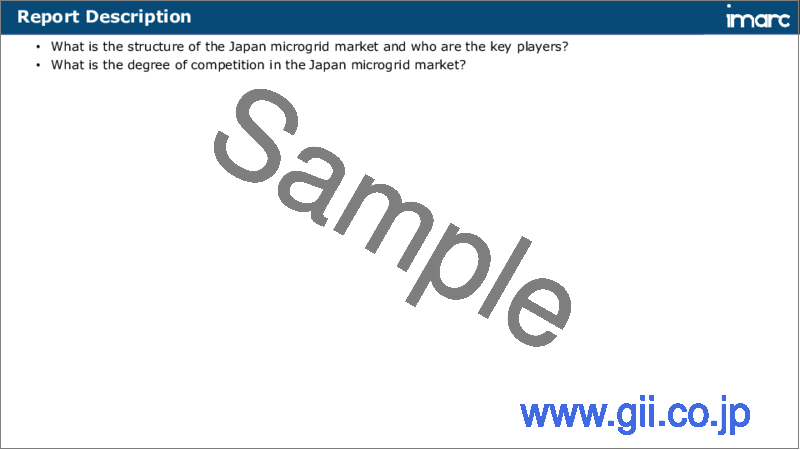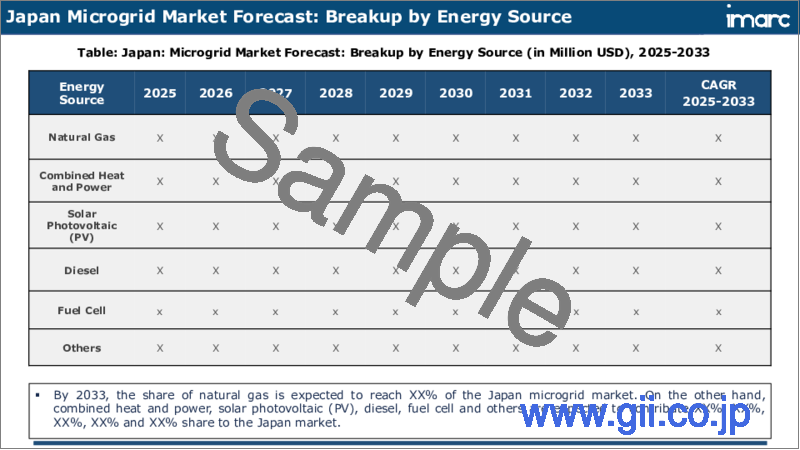|
|
市場調査レポート
商品コード
1609846
日本のマイクログリッド市場レポート:エネルギー源、用途、地域別、2024年~2032年Japan Microgrid Market Report by Energy Source (Natural Gas, Combined Heat and Power, Solar Photovoltaic, Diesel, Fuel Cell, and Others), Application, and Region 2024-2032 |
||||||
カスタマイズ可能
|
|||||||
| 日本のマイクログリッド市場レポート:エネルギー源、用途、地域別、2024年~2032年 |
|
出版日: 2024年12月05日
発行: IMARC
ページ情報: 英文 121 Pages
納期: 5~7営業日
|
- 全表示
- 概要
- 目次
日本のマイクログリッド市場の市場規模は2023年に17億米ドルに達しました。今後、IMARC Groupは、市場は2032年までに73億米ドルに達し、2024年から2032年の間に16.50%の成長率(CAGR)を示すと予測しています。同市場は、エネルギー安全保障向上へのニーズの高まり、信頼性の高い電力への需要の高まり、よりクリーンで持続可能なエネルギーオプションへの関心の高まり、コスト効率の高いエネルギーシステムへのニーズの高まりなど、いくつかの重要な要因によって牽引されています。
本レポートで扱う主な質問
- 日本のマイクログリッド市場のこれまでの業績と、今後数年間の業績は?
- COVID-19が日本のマイクログリッド市場に与えた影響は?
- 日本のマイクログリッド市場のエネルギー源別の内訳は?
- 日本のマイクログリッド市場の用途別の内訳は?
- 日本のマイクログリッド市場のバリューチェーンにはどのような段階があるのか?
- 日本のマイクログリッドの主な促進要因と課題は何か?
- 日本のマイクログリッド市場の構造と主要プレーヤーは?
- 日本のマイクログリッド市場における競合の程度は?
目次
第1章 序文
第2章 調査範囲と調査手法
- 調査の目的
- ステークホルダー
- データソース
- 市場推定
- 調査手法
第3章 エグゼクティブサマリー
第4章 日本のマイクログリッド市場:イントロダクション
- 概要
- 市場力学
- 業界動向
- 競合情報
第5章 日本のマイクログリッド市場情勢
- 過去および現在の市場動向(2018~2023年)
- 市場予測(2024~2032年)
第6章 日本のマイクログリッド市場:エネルギー源別の内訳
- 天然ガス
- 熱電併給
- 太陽光発電(PV)
- ディーゼル
- 燃料電池
- その他
第7章 日本のマイクログリッド市場:用途別の内訳
- リモートシステム
- 機関・キャンパス
- ユーティリティ/コミュニティ
- 防衛
- その他
第8章 日本のマイクログリッド市場:競合情勢
- 概要
- 市場構造
- 市場プレーヤーのポジショニング
- 主要成功戦略
- 競合ダッシュボード
- 企業評価象限
第9章 主要企業のプロファイル
第10章 日本のマイクログリッド市場:業界分析
- 促進要因・抑制要因・機会
- ポーターのファイブフォース分析
- バリューチェーン分析
第11章 付録
Japan microgrid market size reached US$ 1.7 Billion in 2023. Looking forward, IMARC Group expects the market to reach US$ 7.3 Billion by 2032, exhibiting a growth rate (CAGR) of 16.50% during 2024-2032. The market is being driven by several key factors, including the increasing need for improved energy security, a growing demand for dependable power, a rising interest in cleaner and more sustainable energy options, and a greater need for cost-efficient energy systems.
A microgrid is a compact energy system designed to generate, distribute, and oversee electricity either on its own or in coordination with the primary power grid. Typically, it incorporates a mix of renewable energy sources, energy storage units, and traditional generators. This system has the capability to function independently or detach itself from the main grid in situations like power failures or emergencies, ensuring a consistent and dependable power source for a particular region or facility. Due to its adaptability and ability to be tailored to specific energy requirements, there is a rising interest in microgrids.
Japan Microgrid Market Trends:
The microgrid market in Japan is experiencing significant growth and development. With a strong emphasis on energy security, sustainability, and innovation, Japan has become a thriving hub for microgrid technology. The country's susceptibility to natural disasters, such as earthquakes and tsunamis, has spurred a greater need for reliable and resilient energy solutions. Microgrids, with their ability to operate autonomously during power outages or emergencies, are seen as a crucial component of Japan's energy landscape. Additionally, Japan's commitment to reducing its carbon footprint and transitioning towards cleaner energy sources has further boosted the adoption of microgrids, which often incorporate renewable energy technologies. As a result, the Japan microgrid market is poised for continued expansion as it addresses the nation's energy security and sustainability objectives. In accordance with this, microgrids enable institutions to produce electricity on a localized scale, enhancing cost-effectiveness by reducing the dependence on costly grid electricity purchases. Through the effective utilization of renewable energy resources, in conjunction with energy storage and streamlined demand management, these systems can substantially decrease operational expenses. Furthermore, for scenarios where electricity is required in remote or off-grid settings, like mining operations or rural areas, microgrids offer an economical and eco-friendly means of obtaining power, eliminating the necessity for expensive long-distance power transmission infrastructure. This situation is expected to contribute to a favorable market outlook over the forecasted period.
Japan Microgrid Market Segmentation:
Energy Source Insights:
- Natural Gas
- Combined Heat and Power
- Solar Photovoltaic (PV)
- Diesel
- Fuel Cell
- Others
Application Insights:
- Remote Systems
- Institution and Campus
- Utility/Community
- Defense
- Others
Competitive Landscape:
The market research report has also provided a comprehensive analysis of the competitive landscape in the market. Competitive analysis such as market structure, key player positioning, top winning strategies, competitive dashboard, and company evaluation quadrant has been covered in the report. Also, detailed profiles of all major companies have been provided.
Key Questions Answered in This Report:
- How has the Japan microgrid market performed so far and how will it perform in the coming years?
- What has been the impact of COVID-19 on the Japan microgrid market?
- What is the breakup of the Japan microgrid market on the basis of energy source?
- What is the breakup of the Japan microgrid market on the basis of application?
- What are the various stages in the value chain of the Japan microgrid market?
- What are the key driving factors and challenges in the Japan microgrid?
- What is the structure of the Japan microgrid market and who are the key players?
- What is the degree of competition in the Japan microgrid market?
Table of Contents
1 Preface
2 Scope and Methodology
- 2.1 Objectives of the Study
- 2.2 Stakeholders
- 2.3 Data Sources
- 2.3.1 Primary Sources
- 2.3.2 Secondary Sources
- 2.4 Market Estimation
- 2.4.1 Bottom-Up Approach
- 2.4.2 Top-Down Approach
- 2.5 Forecasting Methodology
3 Executive Summary
4 Japan Microgrid Market - Introduction
- 4.1 Overview
- 4.2 Market Dynamics
- 4.3 Industry Trends
- 4.4 Competitive Intelligence
5 Japan Microgrid Market Landscape
- 5.1 Historical and Current Market Trends (2018-2023)
- 5.2 Market Forecast (2024-2032)
6 Japan Microgrid Market - Breakup by Energy Source
- 6.1 Natural Gas
- 6.1.1 Overview
- 6.1.2 Historical and Current Market Trends (2018-2023)
- 6.1.3 Market Forecast (2024-2032)
- 6.2 Combined Heat and Power
- 6.2.1 Overview
- 6.2.2 Historical and Current Market Trends (2018-2023)
- 6.2.3 Market Forecast (2024-2032)
- 6.3 Solar Photovoltaic (PV)
- 6.3.1 Overview
- 6.3.2 Historical and Current Market Trends (2018-2023)
- 6.3.3 Market Forecast (2024-2032)
- 6.4 Diesel
- 6.4.1 Overview
- 6.4.2 Historical and Current Market Trends (2018-2023)
- 6.4.3 Market Forecast (2024-2032)
- 6.5 Fuel Cell
- 6.5.1 Overview
- 6.5.2 Historical and Current Market Trends (2018-2023)
- 6.5.3 Market Forecast (2024-2032)
- 6.6 Others
- 6.6.1 Historical and Current Market Trends (2018-2023)
- 6.6.2 Market Forecast (2024-2032)
7 Japan Microgrid Market - Breakup by Application
- 7.1 Remote Systems
- 7.1.1 Overview
- 7.1.2 Historical and Current Market Trends (2018-2023)
- 7.1.3 Market Forecast (2024-2032)
- 7.2 Institution and Campus
- 7.2.1 Overview
- 7.2.2 Historical and Current Market Trends (2018-2023)
- 7.2.3 Market Forecast (2024-2032)
- 7.3 Utility/Community
- 7.3.1 Overview
- 7.3.2 Historical and Current Market Trends (2018-2023)
- 7.3.3 Market Forecast (2024-2032)
- 7.4 Defense
- 7.4.1 Overview
- 7.4.2 Historical and Current Market Trends (2018-2023)
- 7.4.3 Market Forecast (2024-2032)
- 7.5 Others
- 7.5.1 Historical and Current Market Trends (2018-2023)
- 7.5.2 Market Forecast (2024-2032)
8 Japan Microgrid Market - Competitive Landscape
- 8.1 Overview
- 8.2 Market Structure
- 8.3 Market Player Positioning
- 8.4 Top Winning Strategies
- 8.5 Competitive Dashboard
- 8.6 Company Evaluation Quadrant
9 Profiles of Key Players
- 9.1 Company A
- 9.1.1 Business Overview
- 9.1.2 Product Portfolio
- 9.1.3 Business Strategies
- 9.1.4 SWOT Analysis
- 9.1.5 Major News and Events
- 9.2 Company B
- 9.2.1 Business Overview
- 9.2.2 Product Portfolio
- 9.2.3 Business Strategies
- 9.2.4 SWOT Analysis
- 9.2.5 Major News and Events
- 9.3 Company C
- 9.3.1 Business Overview
- 9.3.2 Product Portfolio
- 9.3.3 Business Strategies
- 9.3.4 SWOT Analysis
- 9.3.5 Major News and Events
- 9.4 Company D
- 9.4.1 Business Overview
- 9.4.2 Product Portfolio
- 9.4.3 Business Strategies
- 9.4.4 SWOT Analysis
- 9.4.5 Major News and Events
- 9.5 Company E
- 9.5.1 Business Overview
- 9.5.2 Product Portfolio
- 9.5.3 Business Strategies
- 9.5.4 SWOT Analysis
- 9.5.5 Major News and Events
10 Japan Microgrid Market - Industry Analysis
- 10.1 Drivers, Restraints, and Opportunities
- 10.1.1 Overview
- 10.1.2 Drivers
- 10.1.3 Restraints
- 10.1.4 Opportunities
- 10.2 Porters Five Forces Analysis
- 10.2.1 Overview
- 10.2.2 Bargaining Power of Buyers
- 10.2.3 Bargaining Power of Suppliers
- 10.2.4 Degree of Competition
- 10.2.5 Threat of New Entrants
- 10.2.6 Threat of Substitutes
- 10.3 Value Chain Analysis





